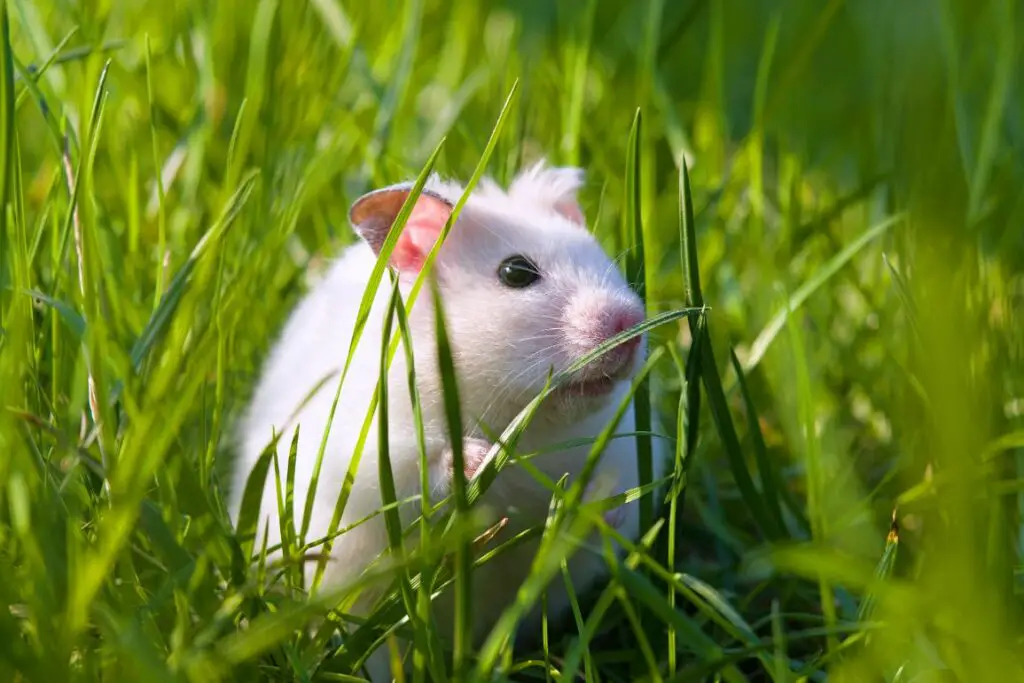Hamsters are small, furry mammals that are often kept as pets. There are several different types of hamsters, including Chinese hamsters, Syrian hamsters, Roborovski hamsters, Winter White hamsters, and Campbell hamsters. While all hamsters share some physical characteristics and potential health issues, each species has its own unique characteristics and lifespan.

In short, here are the lifespans of all the hamster breeds:
- Roborovski hamster: 3 to 4 years
- Syrian Hamster: 2 to 3 years
- Winter White Hamster: 1 to 2 years
- Cambell’s Dwarf Hamster: 1 to 2 years
- Chinese Hamsters: 2 to 3 years
Common Health Issues for Hamsters
Hamsters are prone to several health issues, including dental problems, respiratory infections, and tumors. They can also be affected by parasites such as mites and fleas. It is important to take your hamster to a veterinarian if you notice any signs of illness, such as lethargy, loss of appetite, or changes in behavior. Poor health can affect your hamster’s lifespan and make them live shorter than they normally would.
Factors Affecting Hamster Lifespan
There are several factors that can affect the lifespan of a hamster, including nutrition, environment, exercise, and genetics.
Nutrition and Diet
Hamsters require a diet that is high in protein and fiber, and low in fat and sugar. They should be fed a mixture of pellets, fresh fruits and vegetables, and occasional treats such as nuts or seeds.
Overfeeding or feeding the wrong types of food can lead to obesity and other health problems.
Environment and Habitat
Hamsters require a clean, safe, and comfortable environment in order to thrive. They should be kept in a cage that is large enough to allow for exercise and exploration, with plenty of bedding material and toys to keep them entertained.
Exercise and Activity
Hamsters are active animals and require plenty of exercise and stimulation to stay healthy. They should be given opportunities to run, climb, and explore, either through a hamster wheel or by providing them with a play area outside of their cage.
Genetics
Like all animals, hamsters have genetic factors that can affect their lifespan. Some hamsters may be predisposed to certain health issues, while others may have a longer lifespan due to their genetics.
Lifespan of Different Hamster Species
The lifespan of a hamster can vary depending on the species, with some living only a year and others living up to 4 years.
Chinese Hamster Lifespan
Chinese hamsters have a lifespan of approximately 2-3 years.
Syrian Hamster Lifespan
Syrian hamsters have a lifespan of approximately 2-3 years.
Roborovski Hamster Lifespan
Roborovski hamsters have a lifespan of approximately 3-4 years.
Winter White Hamster Lifespan
Winter White hamsters have a lifespan of approximately 1-2 years.
Campbell Hamster Lifespan
Campbell hamsters have a lifespan of approximately 1-2 years.
Maximizing the Lifespan of Your Hamster
While there is no guaranteed way to extend the lifespan of a hamster, there are several steps that pet owners can take to ensure their hamster lives a long and healthy life.
Caring for Your Hamster as It Ages
As your hamster ages, it may require more specialized care in order to stay healthy. This may include changes to its diet, increased veterinary checkups, and modifications to its living environment.
Preventing Common Health Issues
Pet owners can help prevent common health issues in hamsters by providing them with a clean and safe living environment, feeding them a healthy diet, and taking them for regular checkups with a veterinarian.
Creating a Healthy Environment for Your Hamster
Pet owners can create a healthy environment for their hamster by providing them with a clean and spacious living area, plenty of toys and enrichment activities, and opportunities for exercise and exploration.
The End of Your Hamster’s Life
While it can be difficult to face the end of a pet’s life, it is important to be prepared and know what to expect.
Signs of a Dying Hamster
Signs that your hamster may be approaching the end of its life include lethargy, loss of appetite, difficulty breathing, and changes in behavior or appearance.
How to Comfort Your Hamster During Its Final Days
During your hamster’s final days, it is important to provide them with plenty of comfort and care. This may include providing them with a comfortable and warm living environment, offering them their favorite foods or treats, and spending time with them.
Memorializing Your Beloved Pet
After your hamster has passed away, it can be helpful to memorialize them in some way. This may include creating a photo album or scrapbook, planting a memorial garden, or donating to a hamster rescue or welfare organization in their honor.
Final words
In conclusion, while the lifespan of a hamster can vary depending on several factors such as genetics, nutrition, and environment, there are several steps that pet owners can take to ensure their beloved pets live long and healthy lives. By providing them with a clean and safe living environment, a healthy diet, and plenty of opportunities for exercise and enrichment, pet owners can help their hamsters thrive and enjoy their time together for as long as possible.
- How Long Do American Eskimo Dogs Live? Important Factors and Care Tips - September 29, 2023
- Do American Bulldogs Need Grooming? Essential Tips and Care Guidelines - September 29, 2023
- Do Bengal Cats Enjoy Playing? Essential Tips for Keeping Them Active - September 29, 2023